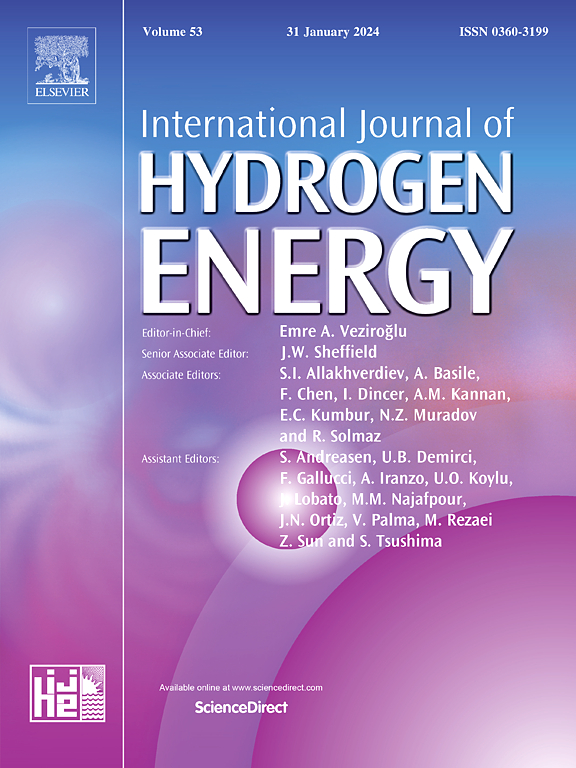Performance evaluation of solar-hydrogen microgrid energy storage system: Comparing low-pressure with simulated high-pressure hydrogen storage
IF 8.3
2区 工程技术
Q1 CHEMISTRY, PHYSICAL
引用次数: 0
Abstract
This paper evaluates two hybrid microgrid hydrogen storage configurations, one with low-pressure storage (35 bar) and one using high-pressure storage (300 bar) with a compressor in a dynamic simulation. Both configurations are coupled with PV generation, lithium-ion batteries, electrolyzers, and a PEM fuel cell. Systems are analyzed under fully islanded (0 % grid), 10 % grid-backup, and 20 % grid-backup scenarios. Electricity-to-hydrogen conversion reaches approximately 55 %, and the PEM fuel cell reconverts hydrogen to electricity at about 46 % efficiency. Overall hydrogen round-trip efficiency ranges from 24.8 % in the islanded case to 32.4 % with 20 % grid support. Low-pressure storage is most cost-effective under moderate grid reliance, whereas high-pressure storage only offsets compressor costs when hydrogen inventories are large. These results inform optimal choices of storage pressure and grid-backup level to maximize hydrogen conversion performance and minimize lifecycle cost in renewable microgrids.
太阳能-氢微网储能系统性能评价:低压与模拟高压储氢比较
本文在动态模拟中评估了两种混合微电网储氢配置,一种是低压储氢(35 bar),另一种是高压储氢(300 bar),并配有压缩机。这两种配置都与光伏发电、锂离子电池、电解槽和PEM燃料电池相结合。系统在完全孤岛(0%电网)、10%电网备份和20%电网备份三种情况下进行分析。电能到氢气的转化率约为55%,PEM燃料电池将氢气转化为电能的效率约为46%。总体氢气往返效率范围从孤岛情况下的24.8%到20%电网支持下的32.4%。在适度的电网依赖下,低压储存是最具成本效益的,而高压储存只有在氢气库存很大时才能抵消压缩机的成本。这些结果为可再生微电网中存储压力和电网备份水平的最佳选择提供了信息,以最大限度地提高氢转换性能并最大限度地降低生命周期成本。
本文章由计算机程序翻译,如有差异,请以英文原文为准。
求助全文
约1分钟内获得全文
求助全文
来源期刊

International Journal of Hydrogen Energy
工程技术-环境科学
CiteScore
13.50
自引率
25.00%
发文量
3502
审稿时长
60 days
期刊介绍:
The objective of the International Journal of Hydrogen Energy is to facilitate the exchange of new ideas, technological advancements, and research findings in the field of Hydrogen Energy among scientists and engineers worldwide. This journal showcases original research, both analytical and experimental, covering various aspects of Hydrogen Energy. These include production, storage, transmission, utilization, enabling technologies, environmental impact, economic considerations, and global perspectives on hydrogen and its carriers such as NH3, CH4, alcohols, etc.
The utilization aspect encompasses various methods such as thermochemical (combustion), photochemical, electrochemical (fuel cells), and nuclear conversion of hydrogen, hydrogen isotopes, and hydrogen carriers into thermal, mechanical, and electrical energies. The applications of these energies can be found in transportation (including aerospace), industrial, commercial, and residential sectors.
 求助内容:
求助内容: 应助结果提醒方式:
应助结果提醒方式:


